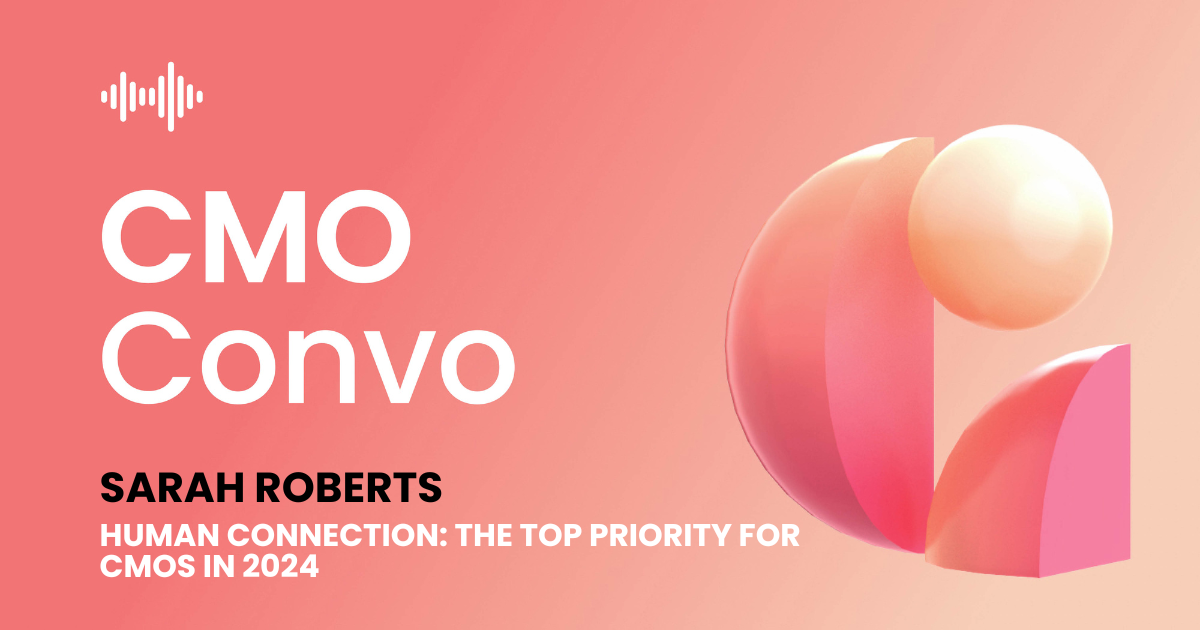The accelerating digital economy continues to dissolve traditional delineations between business-to-consumer (B2C) and business-to-business (B2B) interactions. In recognition, forward-thinking chief marketing officers at B2B companies are wise to thoughtfully incorporate proven consumer brand-building strategies combined with the precision targeting B2B firms excel at.
Implementing select, adapted consumer tactics enables B2B brands to better engage customers, nurture leads, build affinity, and drive growth in today’s omnichannel environment.

Connecting emotionally through storytelling
Leading with product features or functional differentiators has less impact than putting the customer experience front and center. A strong B2C-style brand narrative that decision-makers can connect with emotionally remains vital for B2B success.
As Mai Fenton, CMO of Superscript explains, "We treat the small business owners and decision-makers we serve as humans who, beyond logical decision-making, are also driven by how they can emotionally connect with our brand."
Crafting a compelling brand story and clearly conveying the personality of the company allows potential B2B customers to relate to the offering on a personal level. This establishes familiarity that drives interest, consideration, and advocacy.
Rather than leading with dense specifications, the brand itself becomes the hook that draws positive attention. This gives potential customers added reason to inquire further to understand capabilities. From there informed selling can occur.
"I approached my role at Superscript by giving each side equal emphasis because they both play an important part in driving business growth. So if there was such a thing as B2B CMOs and B2C CMOs, I suppose I would be a hybrid,” - Mai Fenton
Leveraging social media
Social platforms present expansive possibilities for B2B brands to directly engage potential customers where they actively spend time. Beyond LinkedIn, channels like LinkedIn, X/Twitter, and Facebook enable relevant interaction with individual decision-makers and influencers at target companies.
Thoughtful social media marketing creates "pull" interest rather than relying solely on "push" advertising messages. Pull interest is customers proactively seeking you out after exposure to your compelling brand directly or through peers. Push advertising can complement pull interest but is less powerful alone.
Actions like identifying your target audiences, choosing the right channels strategically, establishing a distinct tone of voice, sharing valuable content, highlighting expertise, building trust, and aiming to nurture relationships rather than directly sell are all B2C tactics that can work powerfully in B2B outreach.
Monitoring metrics like revenue generated and customer acquisition costs for each social media platform establishes definitive ROI. This enables CMOs to focus time and budget on the highest-converting social channels and opportunities. Tying social media goals directly to overall business growth objectives ensures strategies remain aligned.
Creating content to attract and engage
Content creation showcases subject matter expertise while building affinity. From blog posts, to videos, to research reports, taking the time to create truly helpful content displays understanding of customer needs while generating inbound interest. This gives potential customers added reason to engage with your brand across digital channels. Truly useful content earns attention without requiring significant media expenditure.
Sponsoring media events, facilitating professional networks, and nurturing influencer partnerships gets your B2B brand directly in front of your audience while they are receptive. Participating as an industry thought leader rather than a direct seller builds credibility.
As Mai Fenton explains regarding Superscript's partnerships, "We found we had quite a rich affinity with cricket lovers, partnering with cricket influencers, so we were able to create some great entertaining content. We were able to get our name out there, and we saw millions of impressions through ESPN social channels.
"We're definitely going to continue to work with ESPN. It proved to deliver great traffic metrics, and more commercial metrics off the back."
Facilitating digital and even in-person communities based on shared passions allows B2B brands and customers to connect as people first, before any business transaction emerges. These authentic human connections encourage organic lead sharing as fellow community members naturally refer your brand to colleagues and partners.
Evaluating similarities and differences
"Whether the target audience is a business decision-maker or a consumer making personal use of products or services, I think the approach to how you market to your audience is similar. Identifying and understanding your buyer personas (or ICP) and buyer journey mapping will inform lead acquisition strategies.
"However, there are certain disciplines and practices that are more prominent in B2B than B2C, that I think would be beneficial for each to learn from the other." - Mai Fenton
So while core marketing foundations like buyer persona development and detailed customer journey mapping apply evenly to both business and consumer realms, tactics like targeted account-based strategies and referral programs have been perfected on the B2B side given longer sales cycles and higher average order values.
Meanwhile, consumer marketers tend to be masters at large-scale brand awareness campaigns amplified across digital channels. B2B marketers can adapt these high-impact omni-channel strategies informed by their surgical precision targeting skills. Blending capabilities together boosts performance.
"My B2C background certainly gave me a different perspective. When I joined Superscript, a lot of my experience gained in B2C influenced my approach..." - Mai Fenton
So for CMOs looking to cross over into new territory by leading either B2B or B2C marketing, taking time to evaluate inherent strengths your past experience brings against desired future goals provides direction. Plot connections between proven strategies you can carry forward against new capabilities needing development. Recognize similarities around customer insights while adding new executional techniques.
Humanizing B2B brands
Certain key differences between B2C and B2B remain around cycle times and lead qualification frameworks. However, the accelerating digital economy blends other factors. Forward-thinking CMOs recognize that thoughtfully incorporating select consumer brand-building strategies creates more relatable brands better positioned for organic growth.
Tactics like social media engagement, online content production, shared interest digital communities, and influencer partnerships overlay neatly atop precision B2B targeting. Blending CMO savvy with the analytical horsepower B2B firms excel at amplifies success.
"Humanize your brand, focus on solving real problems, and build affinity through shared interests," Mai advises. "Apply the best of B2C tactics to make your B2B brand stand out."
So rather than defaulting to historical divisions between marketing B2B offerings versus consumer products, breakthrough marketing leaders strategically bridge the two realms based on customer commonalities. Blend targeted, precision B2B strategies with relatable, engaging B2C campaigns suited for business audiences. Facilitate digital sharing, connect through common passions, and convey helpful thought leadership.
After all, the customer journey for B2B buyers increasingly mirrors elements traditionally associated with consumer selection processes. Meet them where they are digitally. Appeal to hearts and minds. This empathetic, human approach, supported by B2B technical expertise and targeting, powers exponential growth.

Learning the lessons from B2C for B2B marketing
While differences between business-to-consumer (B2C) and business-to-business (B2B) marketing certainly remain in some areas, forward-thinking CMOs recognize that thoughtfully incorporating select consumer tactics creates brands better positioned for growth.
Consumer strategies around social media engagement, online content production, affinity group facilitation, and influencer partnerships overlay effectively atop precision B2B targeting. Blending capabilities together compounds success.
As Mai concludes, "I basically look at our marketing through a B2C lens to build on or complement our B2B marketing initiatives."
So rather than maintaining historical divisions, breakthrough marketing leaders strategically unify relevant realms to engage audiences. Targeted B2B expertise blends with relatable B2C campaigns appealing to hearts and minds. Meet modern buyers where they are, through voices they trust.
Facilitate digital sharing, connect through common interests, and convey thoughtful leadership. This empathetic approach, amplified by B2B technical prowess, powers exponential growth. The way forward fuses precision and emotion to build brands that business decision-makers proudly advocate.
FAQs
Q: Can we use B2C marketing methods and research in B2B?
A: There is tremendous overlap in effective strategies between the two realms.
At the core, business decision-makers are still human beings who respond best when marketing connects with them emotionally and solves real problems they face. So crafting a compelling brand narrative allows potential B2B customers to relate to your company on a personal level, establishing familiarity and trust.
B2C tactics that can be effective for B2B marketing include leading with the customer experience rather than product specs, leveraging social media to directly engage target accounts, creating thought leadership content to attract and nurture leads, and facilitating communities to foster organic sharing.
These techniques build affinity and "pull" interest where prospects proactively seek you out after exposure through peers. Combined with precision B2B targeting, consumer strategies amplify growth.
While some differences remain around sales cycles and lead qualification approaches, humanizing brands around shared passions transcends business-to-consumer versus business-to-business delineations. Meet modern buyers where they are digitally through an empathetic approach.
Selectively incorporating B2C creativity and emotion into your B2B marketing strategy is incredibly effective. Blend these human elements with data-driven precision to drive exponential expansion.
Q: How does B2C position products differently that B2B marketing can take lessons from?
A: Consumer branding often excels at leading with an emotional narrative instead of just functional specs. Crafting a compelling personality allows customers to relate at a personal level.
So rather than purely leading with dense features, make the brand itself the hook drawing interest. Shape the story around experiencing the offering from the user's perspective. Let this customer journey provide the storyline.
B2C marketers also tend to effectively leverage social platforms to engage audiences actively online, generating viral "pull" interest. Likewise, they are masters at omni-channel brand campaigns spanning digital destinations.
While precise B2B targeting remains vital, adapting high-impact creative amplified across media channels compounds success. Meet target decision makers where they consume info.
Consumer marketers also humanize brands via partnerships spanning sports, culture, and causes. Shared affinities transcend B2B/B2C delineations when marketed to hearts and minds.
So the B2C strategies of leading with emotion, leveraging social sharing, launching integrated campaigns, and connecting through passions all enable B2B brands to better relate with modern buyers. Blend these with surgical execution.
What other B2C principles are you applying in B2B marketing? And what about the other way round? If you have insights to share, or questions to ask, share them with a global network of marketing leaders on the CMO Alliance Community Slack channel.




